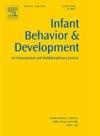Humour from 12 to 36 months: Insights into children’s socio-cognitive and language development
IF 2
3区 心理学
Q3 PSYCHOLOGY, DEVELOPMENTAL
引用次数: 0
Abstract
The relationship between laughter, humour, and socio-cognitive development in infants has attracted scholarly attention, yet structured longitudinal studies remain sparse. This study examines humour appreciation and production in four North American children from the Providence Corpus (Demuth et al., 2006). We annotated 30 min of naturalistic mother–child interactions at six-month intervals (12, 18, 24, 30, and 36 months). We identify 271 humorous episodes following two criteria (Archakis and Tsakona, 2005): (1) the presence of laughter and (2) the identification of an incongruity, i.e. Script Opposition (SO) (GTVH, Attardo (2001)). Each episode was analysed for SO type — im/possible, ab/normal, or non/actual—following Hempelmann and Ruch (2005) hierarchical framework. To explore the developmental relevance, we propose a classification of SOs by knowledge Domains: Natural World & Objects, Social-sphere, and Metalinguistic-sphere.
Findings reveal distinct SO and Domain distributions between mothers and children, developmental trajectories in SOs and Domains, and interactions between them. Between 12 and 30 months, children favoured humourous episodes involving multiple SOs, suggesting a need for multiple cues to interpret mothers’ humorous intent, potentially influencing maternal behaviour. Notably, our results contribute, together with previous studies, in refining McGhee (1979) humour developmental stages, showing that some types of humour emerge earlier than previously postulated. This study provides a detailed investigation of humour in child development from 12 to 36 months, illustrating how humour production and perception reflect cognitive, pragmatic, and linguistic development and offer insights into children’s knowledge acquisition — insights often challenging to access through experimental testing.
12至36个月的幽默:洞察儿童的社会认知和语言发展
婴儿笑声、幽默和社会认知发展之间的关系引起了学术界的关注,但结构化的纵向研究仍然很少。本研究考察了来自普罗维登斯语料库的四个北美儿童的幽默欣赏和产生(Demuth et al, 2006)。我们每隔6个月(12、18、24、30和36个月)记录30分钟的自然母婴互动。我们根据两个标准(Archakis和Tsakona, 2005)确定了271个幽默情节:(1)笑声的存在;(2)不协调的识别,即剧本对立(SO) (GTVH, Attardo(2001))。按照Hempelmann和Ruch(2005)的层次框架,对每一集进行SO类型分析——不可能、正常或非实际。为了探讨发展相关性,我们提出了一个知识领域分类的SOs:自然世界和对象,社会领域,和元语言领域。研究结果揭示了母亲和儿童之间不同的SO和Domain分布、SO和Domain的发展轨迹以及它们之间的相互作用。在12到30个月之间,孩子们更喜欢包含多个SOs的幽默情节,这表明需要多种线索来解释母亲的幽默意图,这可能会影响母亲的行为。值得注意的是,我们的研究结果与之前的研究一起,有助于提炼McGhee(1979)的幽默发展阶段,表明某些类型的幽默比之前假设的更早出现。本研究对12至36个月儿童的幽默发展进行了详细的调查,说明了幽默的产生和感知如何反映认知、语用和语言的发展,并为儿童的知识获取提供了见解——这些见解通常难以通过实验测试获得。
本文章由计算机程序翻译,如有差异,请以英文原文为准。
求助全文
约1分钟内获得全文
求助全文
来源期刊

Infant Behavior & Development
PSYCHOLOGY, DEVELOPMENTAL-
CiteScore
4.10
自引率
4.80%
发文量
94
期刊介绍:
Infant Behavior & Development publishes empirical (fundamental and clinical), theoretical, methodological and review papers. Brief reports dealing with behavioral development during infancy (up to 3 years) will also be considered. Papers of an inter- and multidisciplinary nature, for example neuroscience, non-linear dynamics and modelling approaches, are particularly encouraged. Areas covered by the journal include cognitive development, emotional development, perception, perception-action coupling, motor development and socialisation.
 求助内容:
求助内容: 应助结果提醒方式:
应助结果提醒方式:


